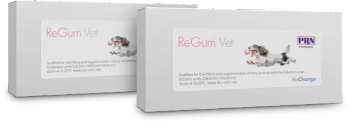
Rodent dentistry (Proceedings)
There are considerable anatomical differences in dental anatomy and physiology between guinea pig-like, rat-like and squirrel-like rodents.
Dental Disease of Rodents
Normal dental anatomy and physiology
There are considerable anatomical differences in dental anatomy and physiology between guinea pig-like, rat-like and squirrel-like rodents. Understanding these differences is critical for correct diagnosis and treatment. Among the more important differences are overall numbers of teeth, and patterns of growth. Teeth that continue to erupt throughout the life of the animal are called elodont. Teeth that grow for a short period, and then cease erupting are anelodont. Unlike rabbits and guinea pig-like pet rodents (guinea pigs, chinchillas, and degus), the premolars and molars (cheek teeth) of rat and squirrel-like rodents are anelodont. Therefore, "overgrown molars" are not a disease entity in these species (Table 2).
Table 1. Specialized equipment used for rodent dentistry.
Pathophysiology of dental disease
In guinea pig-like rodents, dental disease of incisors can be traumatic in origin, but is most commonly secondary to dental disease of the cheek teeth. Dental disease of cheek teeth is usually due to improper wear. Metabolic bone disease in these species has not been investigated, and congenital malocclusion due to jaw malformation has not been documented. Therefore, dental disease in guinea pigs is most likely considered acquired.
Table 2. Dental patterns of common pet rodents.
Dental disease of rat and squirrel-like rodents is usually related to trauma, often secondary to chewing on cage enclosures or attempting to eat inappropriately large or hard food items, such as large nuts or seeds. Traumatic injuries to incisors can lead to malocclusion, while traumatic injuries to cheek teeth usually result in fractures, carries or dental abscesses. Congenital brachygnathism has been described in hamsters, resulting in incisor malocclusion. Pseudo-odontoma of Prairie Dogs is caused by dysplasia of the roots of the maxillary incisors, likely secondary to constant chewing of cage bars. Repeated trauma impairs eruption of the maxillary incisors, leading to root deformation that ultimately acts as a space-occupying mass, reducing air passage through the nasal cavity.
Clinical signs and symptoms
Signs and symptoms of dental disease in rodents and often similar to rabbits, and most commonly include anorexia or reduced food intake, dysphagia, weight loss and gastrointestinal disturbances. Dental disease resulting in abscessation may present as a palpable firm mass or swelling. Guinea pig-like rodents with continuously erupting cheek teeth may develop epiphora due to involvement of the nasolacrimal duct. Prairie Dogs with pseudo-odontoma present with varying degrees of worsening upper respiratory symptoms and exercise intolerance. It should be noted that in some cases severe dental disease is inapparent to owners, due to difficulties directly observing teeth in these species. Rodents with severe incisor malocclusion often adapt to their disability, and do not present until disease is advanced.
Diagnosis
The oral cavity of rodents is difficult if not impossible to evaluate without general anesthesia. Incisor deformation can be readily apparent, but disease affecting cheek teeth requires anesthesia and proper instruments to be appreciated. A variety of dental speculums and other instruments are available for this purpose (table 2). The endoscope is an extremely valuable tool for direct visualization of the oral cavity.
As in rabbits, radiographs are a valuable tool for the evaluation of the jaw, relative tooth position and the roots. Abnormalities that can be detected on dental radiographs include fractures below the gingiva, root abnormalities, osteomyelitis or other evidence of infection, and pseudo-odontoma in Prairie Dogs. Due to the unique sloped angle of the cheek teeth of guinea pigs, the occlusal plane is not visible on lateral radiographs, but must be evaluated with a rostral-caudal view.
Treatment
The goal of treatment of dental disease in all species is return of anatomy and physiology to as close to normal as possible, and control of associated infection and inflammation. Techniques for restoration of normal tooth length and occlusal plane of elodont incisors and cheek teeth are discussed in dental diseases of rabbits. Under no conditions should overgrown teeth be removed or reduced with clippers or rongeurs, as iatrogenic trauma to the remaining crowns and roots is highly likely, especially with repeated treatments. Loose, fractured or otherwise severely damaged teeth can be extracted, but can be considerably more difficult in smaller species. The incisors of most rodents are extremely long and curved, and iatrogenic trauma to jaw structures is possible, especially during extraction of mandibular incisors in smaller species such as hamsters.
It should be kept in mind that guinea pigs in chinchillas with severe elongation of cheek teeth often require very long recovery periods and hand feeding even after appropriate treatment, as the muscles of mastication are often abnormally stretched and damaged. Healing of muscle alone may take several weeks, and during that time, cheek teeth continue to grow. For that reason, the author often finds it necessary to perform multiple reductions a week or so apart until muscle heals and the animal is again able to crush and chew fibrous food.
Treatment of odontoma includes extraction of the maxillary incisors, which is extremely difficult, and roots are often hyperplastic and difficult to separate from surrounding hard and soft tissues. Alternative techniques such as rhinotomy have been described.
Treatment of dental-related abscess is similar to that described for rabbits, with marsupialization and repeated debridement and flushing. Resolution of abscess is extremely difficult without removal of infected teeth and/or bone.
Newsletter
From exam room tips to practice management insights, get trusted veterinary news delivered straight to your inbox—subscribe to dvm360.






